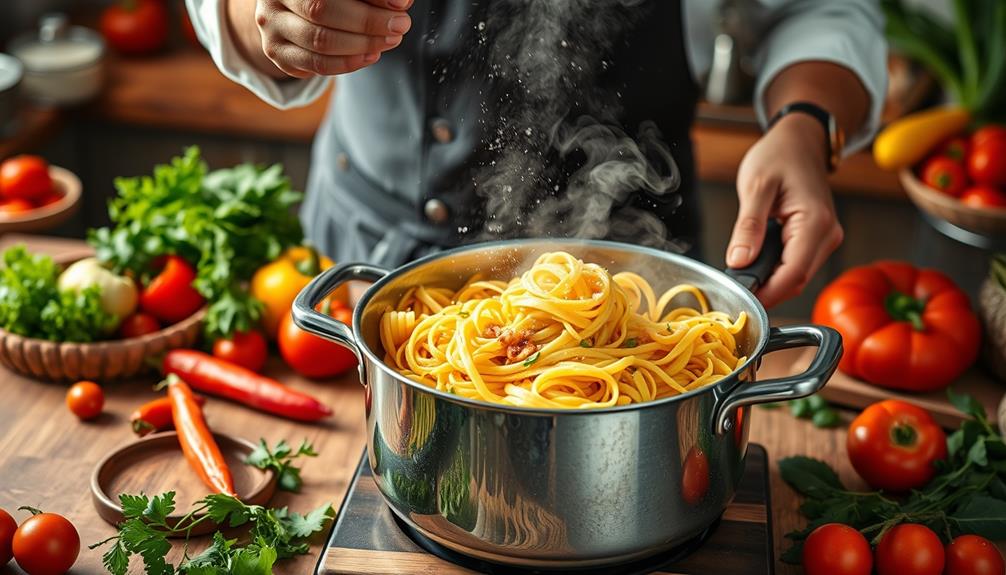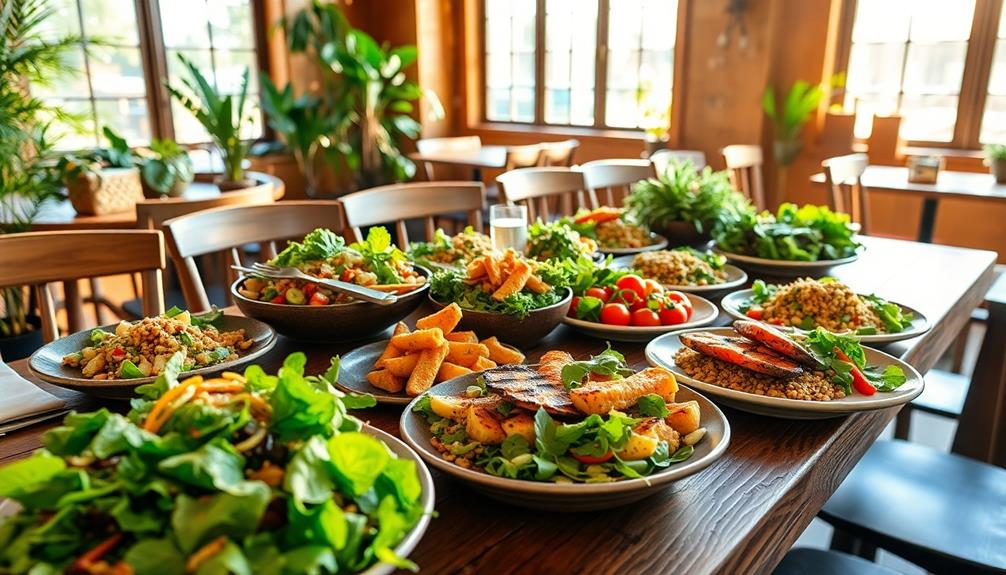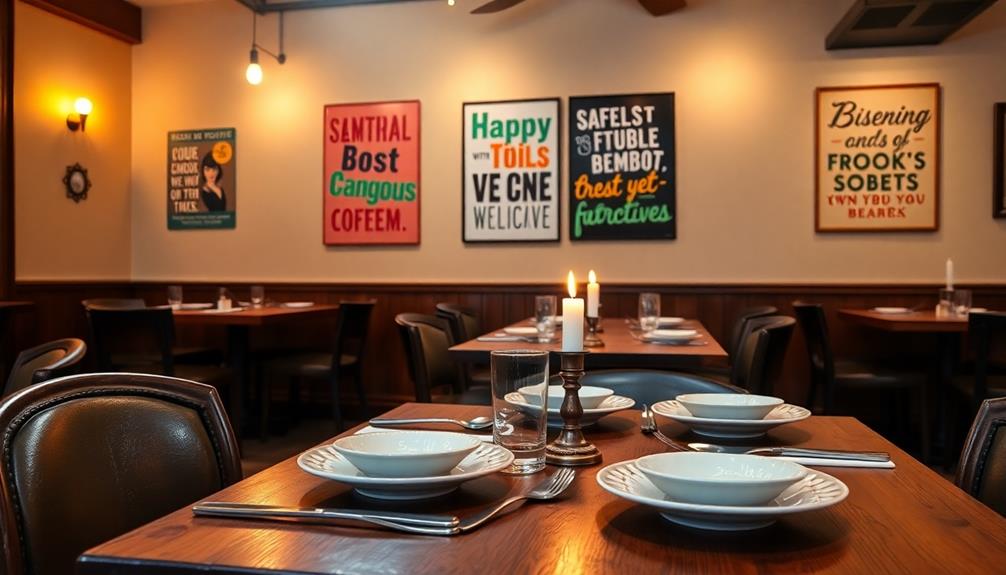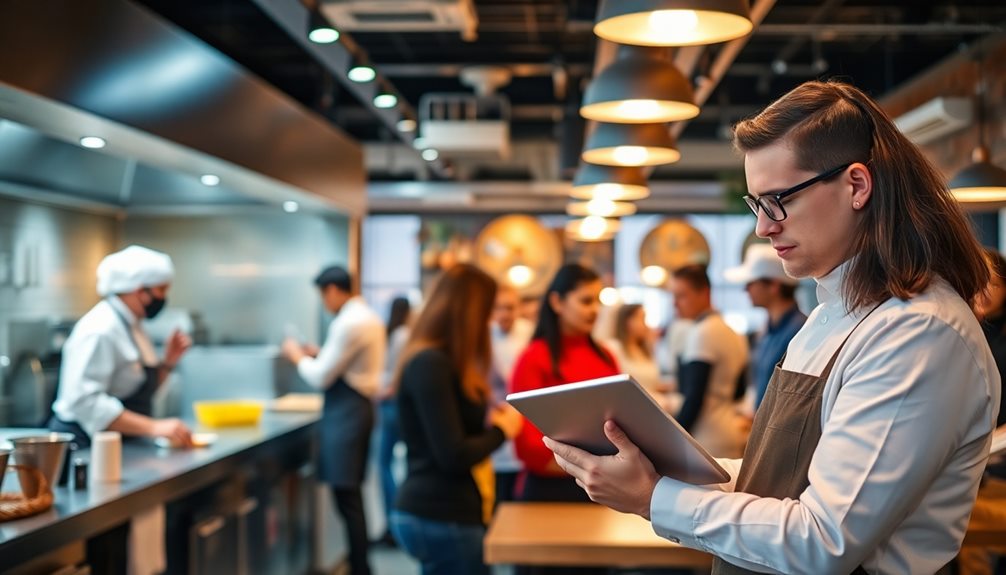In Texas, you'll typically pay a restaurant tax rate of 8.25%, which includes both state and local sales tax. This tax applies to prepared foods and beverages served in restaurants, whether you dine in or take out. Keep in mind that non-reusable meal accompaniments like napkins and plastic utensils are tax-exempt. If you redeem a gift card for a meal, that meal is still subject to tax. Understanding these details can help you budget for your dining expenses effectively. Want to know more about taxable items and local variations? The information is just around the corner.
Key Takeaways
- The state sales tax rate for restaurants in Texas is 6.25%, with local taxes potentially raising it to a total of 8.25%.
- Combined sales tax rates for restaurant services typically reach 8.25%, applicable to dine-in and takeout meals.
- Prepared food and beverages, including mixed drinks, are generally taxable at the 8.25% rate in Texas.
- Non-reusable meal accompaniments, like plastic utensils and napkins, are exempt from sales tax.
- Local jurisdictions may impose additional taxes, resulting in variations in the total sales tax rate on meals.
Texas Sales Tax Overview

When it comes to dining out in Texas, what do you need to know about sales tax? Understanding the Texas sales tax is essential for making budget-friendly dining decisions, especially when considering how it can impact your overall financial health.
The state sales tax rate is 6.25%, but when you add local rates, it can climb to as much as 8.25%. This sales tax applies to prepared food served in restaurants, which includes dine-in and takeout orders.
Certain items, like mixed beverages, also fall under this sales tax rate of 8.25%. However, not everything you encounter at a restaurant is taxable. For instance, non-reusable meal accompaniments, like plastic utensils or napkins, often qualify for tax exemption.
If you're considering purchasing gift cards or certificates, you'll be pleased to know they aren't taxable either; however, the meals you redeem with them will incur the sales tax.
Lastly, don't forget about the distinction between taxable and exempt items—kitchen equipment for food preparation, such as ovens and grills, is exempt from sales tax. Knowing these details can help you navigate your dining expenses more effectively.
Restaurant Tax Rates

Understanding restaurant tax rates in Texas is essential for anyone dining out. The combined sales tax rate for restaurant services typically sits at 8.25%. This rate includes a 6.25% state tax, along with varying local rates that can influence the total you pay.
In Houston, for instance, the Houston sales tax mirrors this statewide rate at 8.25%. This applies not only to meals consumed in the restaurant but also to prepared food sold for takeout. Additionally, mixed beverages served in restaurants are also taxed at the same 8.25% rate.
Here's a quick breakdown of the restaurant tax rates in Texas:
| Category | Sales Tax Rate |
|---|---|
| State Tax | 6.25% |
| Local Tax (Houston) | 2% |
| Total Restaurant Sales Tax | 8.25% |
| Prepared Food (Takeout) | 8.25% |
It's important to note that non-reusable items, like napkins and utensils, are exempt from sales tax. Knowing these rates helps you budget better for your dining experiences.
Tax-Exempt Items for Restaurants

When you're running a restaurant, it's essential to know what items are tax-exempt. Understanding the nuances of tax regulations can help you optimize your expenses and increase profitability.
For instance, non-reusable meal accompaniments like napkins and plastic utensils aren't subject to sales tax in Texas.
Additionally, kitchen equipment needed for food preparation can also save you money by being exempt from tax when purchased, which can be particularly beneficial for new establishments looking to manage costs effectively recommendations for usage.
Non-Reusable Meal Accompaniments
Non-reusable meal accompaniments, like napkins and plastic utensils, play an essential role in dining experiences while also offering significant tax benefits for restaurants in Texas.
These non-reusable items are exempt from sales tax when provided with meals, helping restaurant owners lower their tax burden. Understanding the legal process of divorce can also be beneficial for restaurant owners facing personal challenges, as it may affect their business operations.
The Texas Tax Code specifically distinguishes these items from taxable goods, such as restaurant furniture and reusable utensils.
To take advantage of this exemption, you need to guarantee that the non-reusable items are clearly labeled and included with the purchased meal. By doing so, you'll comply with the regulations while benefiting from reduced sales tax.
It's important to remember that proper documentation is key. Keep receipts or invoices that show the sale of meals along with these non-reusable items. This documentation will be vital in case of audits or assessments, proving your claims of tax-exempt sales.
Kitchen Equipment Exemptions
Kitchen equipment exemptions can considerably impact a restaurant's bottom line in Texas. Understanding which items qualify for these exemptions can help you save a significant amount on sales tax.
In addition to financial benefits, utilizing these exemptions can enhance your overall operational efficiency, much like how a home security system contributes to safety. Here are four key exemptions you should know:
- Food Preparation Equipment: Items like ovens and grills used for food prep are generally exempt from sales tax, making it easier to invest in quality kitchen equipment.
- Non-Reality Repair Labor: The exemption applies to non-realty repair labor for processing equipment. This means you can save on maintenance costs when keeping your kitchen running smoothly.
- Long-Term Rentals: If you lease processing equipment for at least one year, that rental is exempt from sales tax. This can benefit your long-term operational planning.
- Non-Reusable Meal Items: Items like fry bags and plastic utensils provided with meals are also exempt, reducing your overall meal costs.
To take advantage of these exemptions, remember to provide an exemption certificate to the seller for eligible purchases. This will help you maximize savings and improve your restaurant's profitability.
Taxable Items and Services

When you eat out, it's important to know which items and services are taxable. Generally, prepared food and beverages fall under this category, while some equipment and supplies may be exempt.
Understanding the nuances of tax regulations for dining can help you better manage your expenses, especially in a volatile economy.
Let's break down what you need to be aware of regarding taxable food items and services.
Taxable Food Items
In Texas, most prepared food items sold in restaurants are subject to a sales tax of 8.25%. This combined sales tax applies not only to dine-in meals but also to takeout orders.
As a restaurant owner, it's crucial to understand which items fall under this taxable category to guarantee compliance. Additionally, understanding how to manage operational costs, similar to how you'd manage costs associated with toilet flushing mechanisms, can help optimize your restaurant's financial health.
Here are some common taxable food items you'll encounter:
- Dine-in meals: Any cooked food enjoyed on-site incurs the sales tax.
- Takeout meals: Even when food is packaged for off-site consumption, it's still taxable.
- Mixed beverages: Alcoholic drinks sold in your establishment are taxed at the same rate.
- Restaurant furniture and utensils: Items like chairs and serving tools also attract sales tax.
However, not everything is taxable. Non-reusable items, like napkins and plastic utensils, are generally exempt.
Additionally, kitchen equipment used for food preparation, such as ovens and grills, doesn't incur sales tax either. By knowing the taxable food items, you can better manage your finances and avoid any surprises during tax season.
Taxable Services Overview
Understanding the taxable services in the restaurant industry is fundamental for maintaining compliance and financial accuracy. In Texas, restaurant services, including prepared food and to-go orders, are subject to sales tax at a rate of 8.25%. This rate encompasses both state and local taxes, so it's imperative to apply this correctly to your transactions.
Additionally, it's significant for restaurant owners to be aware of financial considerations for elderly care as they navigate their business expenses and taxation.
Beyond food, many services you offer are also taxable. For instance, waste removal and janitorial cleaning services are subject to sales tax, which adds to your overall taxable amount. It's important to keep track of these services to guarantee you're calculating sales tax accurately.
While certain items like furniture and utensils are taxable, not everything you provide falls under this category. For example, non-reusable meal accompaniments such as napkins and plastic utensils are exempt from sales tax.
Additionally, when customers redeem gift cards, the meals they purchase will incur sales tax, so keeping this in mind is critical.
Exempt Equipment and Supplies
Charting the complexities of sales tax in the restaurant industry means knowing which equipment and supplies are exempt from taxation.
Understanding these exemptions can greatly impact your bottom line, especially when considering the best vacuums for dust removal in your restaurant's kitchen for maintaining cleanliness.
Here's a quick list of items that are exempt from sales tax:
- Processing equipment: Most equipment used for food preparation, like ovens and grills, is exempt from sales tax in Texas.
- Non-reusable items: Supplies provided with meals, such as napkins and utensils, also qualify for tax exemption.
- Repairs on processing equipment: Repair services not incorporated into realty are exempt, as are parts for these repairs when separately stated.
- Employee uniforms: Uniforms required for food safety are exempt from sales tax if purchased with a valid exemption certificate.
Calculating Sales Tax

When dining out, calculating the sales tax on your restaurant bill is vital for budgeting your total expenses. In Texas, the sales tax rate on restaurant meals is 8.25%. This includes the state rate of 6.25% plus any local taxes that may vary depending on your location.
To calculate the tax, simply take the total price of your meal and multiply it by 0.0825. Keep in mind that just as you consider the best value for your meal, it's also wise to explore options like precious metal investments for financial planning.
Remember, tax is applied to the total price of prepared food and beverages, whether you're dining in or taking out. However, don't worry about being charged sales tax on non-reusable meal accompaniments like napkins and utensils, as they're exempt.
If you're using a gift card, keep in mind that you'll only pay sales tax on the amount of the meal after the card is applied.
It's important for restaurants to be aware of local tax variations and any exemptions that might apply to specific menu items. By understanding these details, you can confidently calculate the sales tax and guarantee you budget accurately for your dining experience.
Sales Tax Compliance for Restaurants

Restaurants in Texas face specific requirements for sales tax compliance that are essential for smooth operations. Understanding and adhering to these regulations is imperative for maintaining your restaurant's integrity and financial health.
Top platforms include freelance sites that can help restaurant owners find additional revenue streams. Here are some key points to take into account:
In addition to freelance sites, restaurant owners can also explore partnerships with local catering companies or event planning services to tap into a wider customer base. However, it’s important to consider the reputation and quality of these partnerships to ensure they align with the restaurant’s brand. Another avenue to explore is reaching out to michelinstarred restaurants to collaborate on exclusive dining experiences, which can attract a more upscale clientele and bring in additional revenue. But what are michelinstarred restaurants? These are establishments that have been awarded Michelin stars for their exceptional food, service, and overall dining experience. Collaborating with them can elevate the restaurant’s offerings and attract new customers.
- Sales Tax Rate: The combined state sales tax on restaurant services, including prepared food and beverages, is generally 8.25%. This includes a state tax of 6.25% and local taxes.
- Exempt Items: Non-reusable items provided with meals, like napkins and utensils, are exempt from sales tax. However, restaurant furniture and kitchen equipment typically incur tax.
- Mixed Beverages: If you serve mixed beverages, you must collect sales taxes at the same 8.25% rate.
- Record Keeping: It's essential to maintain accurate records of all taxable sales, including takeout orders, to guarantee compliance with regulations set by the Texas Comptroller of Public Accounts.
To avoid penalties, make certain you have a valid Texas Sales and Use Tax permit. Following these guidelines will help you effectively collect sales taxes and keep your restaurant compliant with state sales tax laws.
Local Variations in Tax Rates

Texas's diverse cities can greatly impact the sales tax you collect on restaurant services. In Houston, for example, the combined sales tax rate for restaurant services is 8.25%, which includes a 6.25% state sales tax and a 2% local tax.
However, you might find that local jurisdictions can impose additional local sales taxes, leading to variations in tax rates depending on where your restaurant is located. Staying updated on content relevance and authority is vital for guaranteeing you're aware of any changes in local tax regulations that could affect your business.
If your restaurant is situated in an area without extra local taxes, you'll only charge the standard state sales tax of 6.25%. But in cities that do impose higher local taxes, the total rate could exceed that 8.25% maximum.
It's important to stay informed about the local sales tax rates to make sure you're accurately calculating the sales tax on your customers' bills.
Moreover, keep in mind that the sales tax on mixed beverages served in Texas restaurants follows the same combined sales tax rate of 8.25%. Understanding these local variations in tax rates will help you manage your pricing effectively and maintain compliance with tax regulations.
Resources for Restaurant Owners

For restaurant owners steering through the complexities of tax regulations, leveraging available resources can make a significant difference in managing your business effectively.
Understanding the nuances of sales tax, tax-exempt items, and maintaining accurate records is essential for compliance and financial health. Here are some resources to take into account:
- Local Tax Authorities: Your local tax office provides critical information on the specific sales tax rates and regulations that apply in your area.
- Tax Professionals: Hiring a CPA or tax advisor with experience in the restaurant industry can help you navigate tax laws, identify tax-exempt items like napkins and utensils, and guarantee compliance.
- Industry Associations: Organizations like the National Restaurant Association offer resources, training, and updates on tax regulations affecting restaurant owners.
- Accounting Software: Invest in accounting software tailored for restaurants that tracks sales tax, categorizes taxable and non-taxable sales, and helps maintain accurate records for kitchen equipment and furniture.
Frequently Asked Questions
What Is the Sales Tax in Texas for Restaurants?
In Texas, you'll find the sales tax for restaurants is 8.25%. This rate covers most prepared food and beverages, including dine-in and takeout. Remember, some items like non-reusable utensils are tax-exempt.
Is All of Texas 8.25 Sales Tax?
Not all of Texas has an 8.25% sales tax. While that's the maximum combined rate, local jurisdictions can set their own rates, meaning some areas might charge less. Always check specific local tax rates.
How Much Is Sales Tax in Houston?
When you're dining out in Houston, you'll notice the combined sales tax is 8.25%. While enjoying your meal, remember that certain items, like non-reusable accompaniments, might not be taxed, adding a pleasant surprise.
How Do I Calculate Sales Tax in Texas?
To calculate sales tax in Texas, multiply your purchase amount by the applicable sales tax rate. For example, if you spend $10, you'll owe $0.83 in tax at the maximum combined rate of 8.25%.
Conclusion
Understanding the ins and outs of restaurant tax can seem intimidating, but it's definitely doable. By digging into Texas sales tax details, you'll discover the distinctions between taxable and tax-exempt items. Staying savvy about sales tax compliance can save you from sticky situations. So, keep your kitchen clean and your calculations correct! Remember, mastering taxes is an essential part of your restaurant's success, ensuring you're not just serving delicious dishes but also managing your money wisely.









